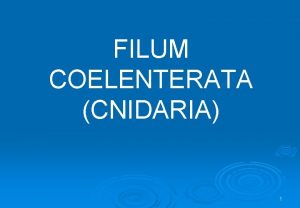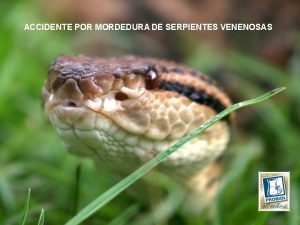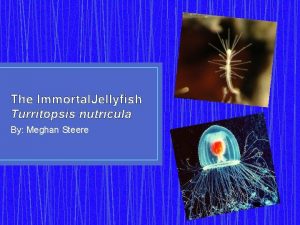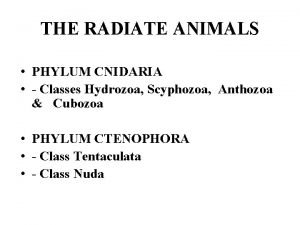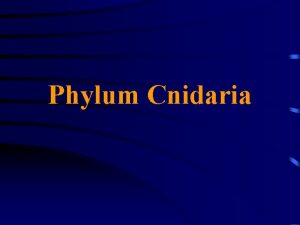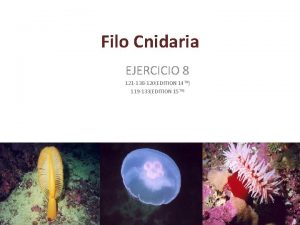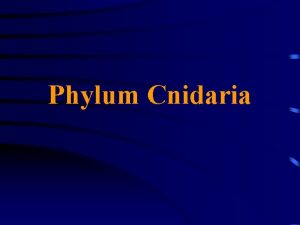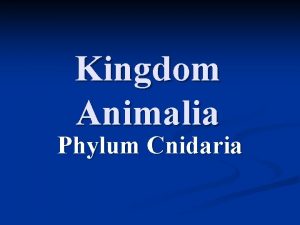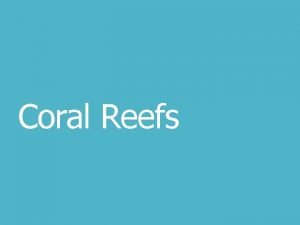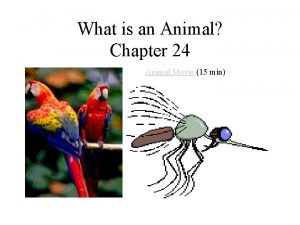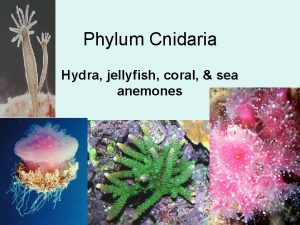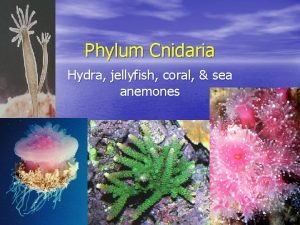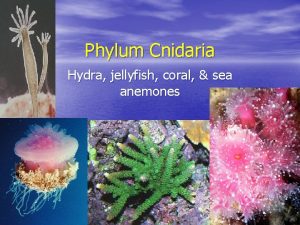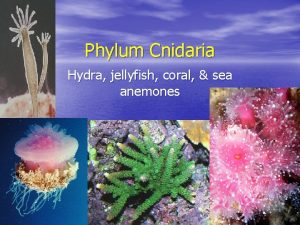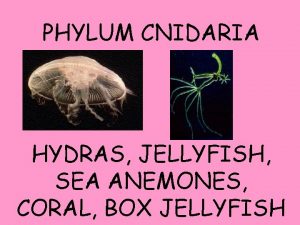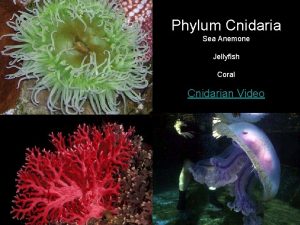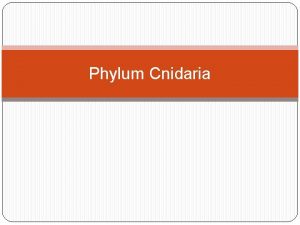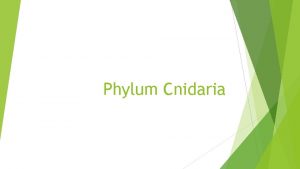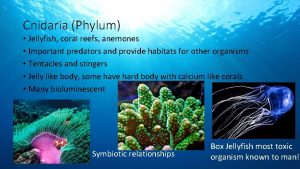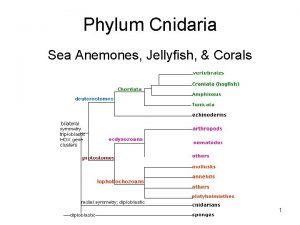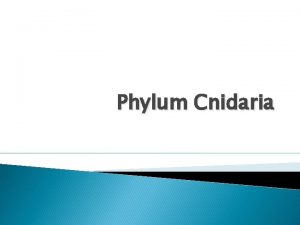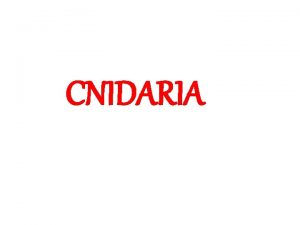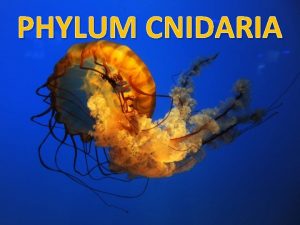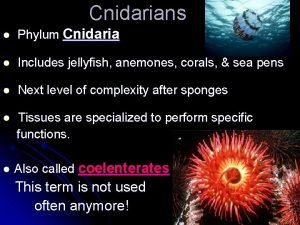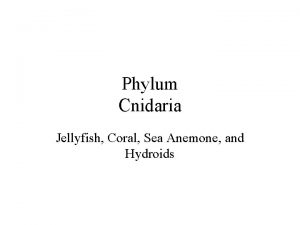Phylum Cnidaria Phylum Ctenaphora Jellyfish Sea Anemones Coral

















- Slides: 17

Phylum Cnidaria & Phylum Ctenaphora Jellyfish, Sea Anemones, Coral, Hydra, Sea Fans and Sea Wasps Comb Jellies

General Characteristics Of Cnidarians -Soft bodied -Carnivorous -Stinging tentacles -Examples: Jellyfish, sea anemones, hydras, corals n

Classes of Cnidaria Hydrozoa - Portuguese man-of-war, hydra Scyphozoa - true jellyfish – Aurelia Anthozoa - sea anenome, corals, sea fans Cubozoa – sea wasps, aka box jellies

Characteristics of Phylum Cnidaria - all aquatic; mostly marine - radially, or biradially symmetrical - acoelomate - no coelom - diploblastic – (two germ layers) - blind (incomplete) gut - 2 body types – free-swimming medusa sessile polyps

Characteristics of Cnidarians (con’t) - tentacles - around mouth/oral region - have specialized stinging cells – cnidocytes Cnidocytes have organelles called cnidae. Cnidae - over 30 types -some are sticky and serve as an anchor -some are toxic - a cnidarian may have more than 6 types!

Nematocysts - most common type of cnida - used to inject a toxin - used for defense and to capture prey Only a few jellyfish, ex. Portuguese man-of-war, can seriously harm humans

Characteristics of Cnidarians (con’t) statocyst - sensory organ for balance ocelli - photosensitivity nerve net, simple system, no brain neurons sense physical contact reproduction asexual - budding in polyps sexual - in all medusae & some polyps monoecious or dioecious No excretory or respiratory system

Cnidarian body plans: Polyp -internal body cavity -adaptation to a sedentary life -tubular body; mouth directed upward and surrounded by tentacles -reproduce asexually by budding, fission, or pedal laceration (sea anemones); sexually by broadcasting sperm & egg into water

Medusa - bell or umbrella-shaped - usually free-swimming - mouth directed downward - tentacles may extend down from rim of medusa - statocysts for balance or direction - ocelli for light/vision

Cnidarian Body Wall Outer epidermis mesoglea Inner gastrodermis Gastrovascular cavity (gut)

Nematocyst discharged - seen by scanning electron microscope

Kingdom Animalia – Cnidaria All cnidarians have specialized stinging or adhesive structures called cnidae Discharge acceleration is at 40, 000 g!!! When triggered, the cnidocyte cells discharge the cnidae. A specialized form of cnidae called the nematocyst, has a harpoon like structure that enters the flesh of the potential predator or prey, releasing neurotoxins. Need both physical and chemical stimulation to induce release. Why do you think this is?


Feeding and Digestion Polyps -Typically carnivorous -Catch prey with tentacles ; pass them to gastrovascular cavity -Gland cells discharge enzymes to begin extracellular digestion -Intracellular digestion continues in gastrodermis

Class Hydrozoa: Animals Hydra Found in fresh water Worldwide distribution (16 species in North America) Body is a cylindrical tube Ring of 6– 10 hollow tentacles encircles mouth Portuguese Man-of-War Floats on surface (air bladder) Tentacles reach up to 10 meters Contains polyp colonies and medusa Air bladder contains gases released

Class Anthozoa Corals Secrete calcium carbonate to form “exoskeleton” - reef builders - attach to solid structures - zooxanthellae Sea Fans or Sea Whips Secrete gorgonin, a more flexible substance than calcium carbonate - attach to sea bottom, sand - zooxanthellae

Characteristics of Ctenophora Long classified as jellyfish, recently recategorized Only animal that swim by means of cilia Range from a few millimeters to 1. 5 m in size Layer of epidermis and gastrodermis with layer of mesoglea (jelly) between – single in Cnidarians, double in Ctenophora Nerve net Specialized colloblast cells as opposed to nematocysts Most are hermaphroditic Does possess an anal pore though most material is ejected through the main Often prey of turtles and jellyfish
 Hydra jellyfish sea anemone sea urchin
Hydra jellyfish sea anemone sea urchin Jellyfish coelenterata
Jellyfish coelenterata Coral y falso coral diferencias
Coral y falso coral diferencias Immortal jellyfish phylum
Immortal jellyfish phylum Man o war habitat
Man o war habitat Cnidocytes jellyfish
Cnidocytes jellyfish Obelia diagram
Obelia diagram General characteristics of cnidaria
General characteristics of cnidaria Ctenophora cnidaria
Ctenophora cnidaria Hydrant cnidaria
Hydrant cnidaria Phylum cnidaria general characteristics
Phylum cnidaria general characteristics Kingdom animalia phylum cnidaria
Kingdom animalia phylum cnidaria Coral reef food chain
Coral reef food chain Asymmetrical
Asymmetrical Sea stump
Sea stump What is asias largest desert
What is asias largest desert Led soldiers across hellespont into anatolia
Led soldiers across hellespont into anatolia Marlin symbolism
Marlin symbolism

